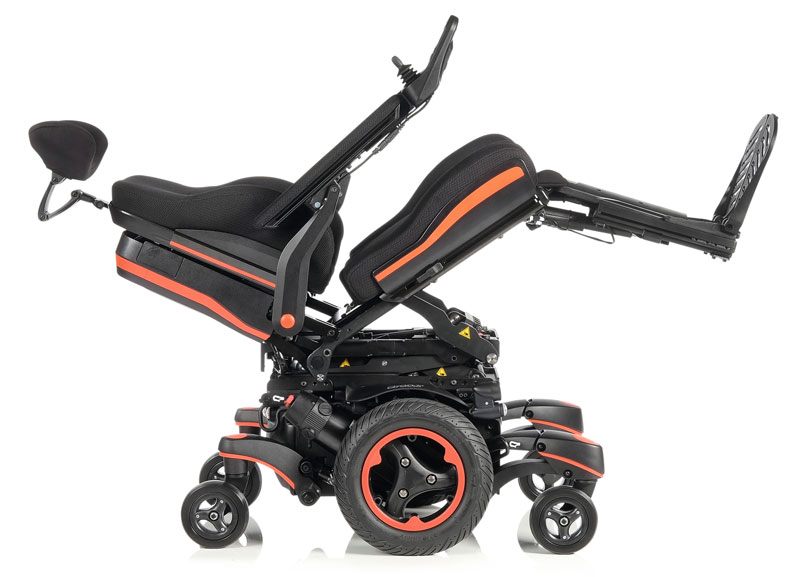We know that unrelieved pressure upon weight-bearing tissues can produce lesions and the prevalence is high - up to 28% for the elderly living in care facilities and between 50% and 80% of persons with a spinal cord injury will develop a pressure injury at some point in their life. Other factors, both intrinsic and extrinsic, also predispose load-bearing tissue to mechanical damage; friction, heat, moisture, incontinence, and less than optimal nutrition can impact skin health and need to be considered. Sitting without position change is also strongly correlated to discomfort, pain, and postural asymmetries. The body just doesn't cope well with sitting for long stretches of time.
Typically, for full-time power wheelchair users, we look to power seat functions to reduce skin risk, create rest, provide relief, and increase comfort. But how do we know what to recommend to our clients? The research tells us a few key facts:
- Tilt, when used alone, must be greater than 25° to achieve pressure relief and/or tissue perfusion at the ischial tuberosities.1
- At a position of 40° tilt with 100° recline, the peak pressure index at the ischial tuberosities and sacrum decreased by 40%. Greater angles of tilt and recline generally provide better pressure relief.2
- The greatest reductions occur when tilt and recline are used together, either at tilt of 35° with recline 100° or tilt of 15°-25° with recline of 120°.3
- Power seat functions are utilized most for comfort. Angles of tilt of 5°-15° and recline of 95°-110°.4
- Performing tilt of 35° with recline of 120° for a duration of three minutes is more effective than a duration of one minute in enhancing skin perfusion.5
- Encouraging periodic movement improved posture and productivity, and it decreased pain.6
However, we also know that many clients do not use their power seat functions as we prescribe - in either frequency or amount of position change. Studies find that typical use is somewhat less than desirable:
- The majority of at-risk individuals do not adhere with the pressure relieving frequency or magnitude of movements currently recommended, indicating a need for pressure ulcer prevention to be explored further.7
I'm a firm believer that to create a behavior change three elements are involved:
- Client needs to understand the rationale and believe in it.
Does the client understand what the power seat functions are meant to do? Truly?
- There needs to be a reason to change the behavior:
Figure out what is motivating to the client. Stick or carrot? Facts? Trial?
- Make it easy and simple:
- Ensure that switches are within easy reach in all positions even full tilt, full recline.
- I sometimes like to latch an actuator switch so the seat function moves into a full tilt without having to hold the button.
- Minimize scrolling through multiple menus and options to activate the seat function. A switch box should be mounted in an easy-to-access location, remote buttons can function as a direct toggle or buttons on the joystick can be assigned to power seat functions.
- Program "memory positions" so that a personalized seat position can be easily entered. This might be a combination of tilt, leg elevation, and back recline that offers both rest and skin protection. You can also use the programmed memory positions to create positions for specific tasks - such as entering a van, driving up an incline, or navigating a curb cut. These memory positions can then be assigned to buttons on the joystick, switch box, or even remote switches.

Research has also told us that information alone isn't enough; we need reminders and motivators in order to substantially change a behavior.
Providing timely cues, accessible instructions, and feedback were critical to facilitating desired health behavior.
- Reminder in conjunction with education program increased compliance 40% when compared to education alone.8
Power wheelchair electronics now allow us to program either visual or auditory reminders for position change. Program the position, frequency, and duration of the position change - a nice "reminder" that they've been in one position for too long! Link this to one of the programmed Memory Positions and latch it! Now that's action!
If you would like more information regarding Memory Positions, please visit our website or speak with your local rehab technology provider.
Clinical Support Information Citations
- Jan, Y.-K., Jones, M. A., Rabadi, M. H., Foreman, R. D., & Thiessen, A. (2010). Effect of wheelchair tilt-in-space and recline angles on skin perfusion over the ischial tuberosity in people with spinal cord injury. Archives of physical medicine and rehabilitation, 91(11), 1758-1764.
- Giesbrecht, E., Ethans, K., & Staley, D. (2011). Measuring the effect of incremental angles of wheelchair tilt on interface pressure among individuals with spinal cord injury. Spinal cord, 49(7), 827-831.
- DiCianno, B., Lieberman, J., Schmeler, M., Schuler, A., Cooper, R., Lange, M., Liu, H., Yih-Kuen, J., (2015) RESNA Position on the Application of Tilt, Recline, and Elevating Legrests for Wheelchairs: 2015 Current State of the Literature.
- Frank, A. O., De Souza, L. H., Frank, J. L., & Neophytou, C., (2012). The pain experiences of powered wheelchair users. Disability and Rehabilitation, 34(9), 770-778.
- Jan, Y.-K., Liao, F., Jones, M. A., Rice, L. A., & Tisdell, T. (2012). Effect of durations of wheelchair tilt-in-space and recline on skin perfusion over the ischial tuberosity in people with spinal cord injury. Archives of physical medicine and rehabilitation, 94(4), 667-672.
- Cardon, G., DeClercq, D., De Bourdeaudhuij, I., & Breithecker, D. (2004). Sitting habits in elementary schoolchildren: a traditional versus a "Moving school". Patient education and counseling, 54(2), 133-142.
- Schofield, R., Porter-Armstrong, A., & Stinson, M. (2013). Reviewing the literature on the effectiveness of pressure relieving movements. Nursing research and practice. http://dx.doi.org/10.1155/2013/124095. Accessed January 16, 2014., 2013, 13 pages.
- Liu, H.-Y., Cooper, R., Kelleher, A., & Cooper, R. A. (2013). An interview study for developing a user guide for powered seating function usage. Disability and Rehabilitation: Assistive Technology(0), 1-14.